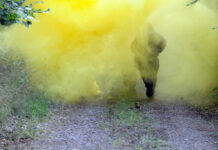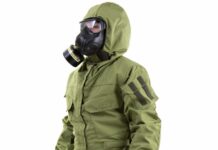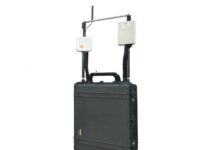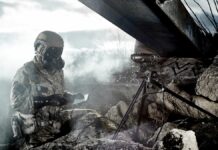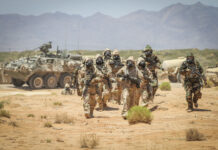This correspondent has covered various aspects of the Chemical, Biological, Radiological, and Nuclear (CBRN) detection business for a number of years in this magazine, often with emphasis on manufacturers and markets. The manufacturers and markets remain largely the same as discussed in the past. As an active consultant in the field, your correspondent is often explaining many fundamental basics of the CBRN detection field. As such, an overview of exactly what detection technologies are in use and what they are actually used for in the field, seems in order. Detection is sometimes treated by the uninitiated as an end unto itself – but detectors are only as good as the decisions the user makes with the information they produce.
What to the layperson might be called ‘CBRN detection’ is actually a large bundle of tasks. Hardware is configured in many different ways in this space. ‘CBRN detection’ as a broad category of equipment, includes, of course actual detection, answering the question “is there a threat present?” in a way not dissimilar to a household smoke alarm. There is also identification, which seeks to identify a hazard. Measurement seeks to provide a qualitative or quantitative measurement of a substance. ‘Monitoring’ is a broader term, often used, which means several different things, depending on country and context. These different types of instruments can be used for a variety of military missions. Products and markets have evolved for all of the mission sets described below.
The most easily understood mission is warning. Detection equipment can provide warning that allows protective measures to be taken. In chemical terms, this means taking rapid protective actions like putting on masks or closing up hatches of vehicles. In radiological terms, it means moving away from a hazard, limiting time near a hazard, or putting shielding between a person and a hazard. These are broadly termed as ‘detect to warn’. In biological terms, the hardware simply does not work as quickly or as accurately, so there’s a term called ‘detect to treat.’ This phrase means detecting quick enough to allow medical interventions. Again, a lot of this is similar to the household smoke alarm – the alarm goes off and everyone runs out of the house, saving their lives. Most of these technologies and products are ‘point detection’ which detects on the spot, not at a distance. ‘Standoff detection’ – the ability to do it at a distance, is becoming more credible in chemical detection. However, many challenges in that segment persist, as has been discussed previously in this magazine. (See ESD issue 01-2018)

Credit: US Army/Spc. Eric Unwin
A variant on the detection mission is dosimetry. This, at present, is only a radiological concept. Dosimetry measures the accumulated radiation dose over a period time. A moderate dose rate of radiation that might be not particularly worrisome for an hour might be exceedingly problematic over the course of days or weeks. Therefore, as with civilian workers in medicine and nuclear power, there are scenarios when military personnel need to monitor their accumulated exposure to radiation.
Another mission for detection equipment is ‘contamination avoidance.’ If you take many individual detections, along with reporting about enemy incidents, you can start plotting them on a map and doing some calculations which range from abject guesswork all the way to highly sophisticated computer modelling. These calculations will yield a plot on a map that gives an estimate of where contamination or hazards might be found. Such plots, in theory, can be used to help plan offensive and defensive operations. However, because of the general lack of CBRN warfare in modern times, decades contamination avoidance doctrine is largely untested.
Another role for detection instruments is point source monitoring. This is the detection of a hazard on a surface. This can be of great value in several types of military operations. CBRN reconnaissance uses such monitoring to check if a route or operating area has been contaminated. These are referred to as route or area CBRN surveys, which serve to verify and update the hazard areas calculated in contamination avoidance procedures.
Point source monitoring also has a valuable role in decontamination. Decontamination is time-consuming and resource-intensive. But with detection equipment, personnel, terrain, and vehicles can be tested to see if there really is contamination. The effectiveness of decontamination can be evaluated using detection equipment. Much use of radiation detection to check decontamination was publicly viewed after the Fukushima nuclear accident.
As a practical matter, CBRN detection and point source monitoring can be heavily affected by background. There is always radiological and biological background; biological background is one of the many reasons that real-time biological detection is still unavailable. Chemical background becomes a problem as well, not just on the battlefield where smokes, fuels, and vehicle exhaust are problematic. It is also a problem in urban environments, where household cleaning products and gardening chemicals are but a few of the chemical ‘background noise’ problems that cause false positives.
In more specialised roles and missions, identification of unknown substances becomes a valid operational requirement. Usually, this is more time-consuming and often requires more specialised sensors. Verifying use of chemical warfare agents on the battlefield has global political ramifications. There are also many potential scenarios where military forces might encounter unknown substances. First alleged use of CBRN material on a battlefield is a serious allegation requiring impeccable investigation. Possible manufacture of CBRN materials or weapons by insurgency or irregular forces is a threat in some potential operation. As such, a whole mission set of SIBCRA (Sampling and Identification of Biological, Chemical and Radiological Agents) has evolved. This has yielded both man-portable identification instruments that can be taken to the field by specialised teams and small deployable laboratories which can process samples in theatre without having to transport them long distances for analysis.
The various different types of CBRN detection missions are summarised in the table below:
| Detect to Warn | Providing rapid warning to deployed troops to allow them to take protective measures like donning masks. Speed at a premium. Proliferated sensors, so economy also at a premium |
| Detect to Treat | Accurate analysis of threats to allow proper medical prophylaxis or treatment. Accuracy more important than speed |
| Contamination Avoidance | Provide information to allow for situational awareness of where hazards may be present on the battlefield |
| Route and Area Survey | Determining whether a route or specific area has chemical or radiological contamination. Ruggedness and speed required. |
| Decon Quality Control | Checking whether decontamination has been performed adequately. Ruggedness at a premium. |
| SIBCRA | “Sampling and Identification of Biological, Chemical and Radiological Agents” – detailed analysis of samples and identification of unknown materials. Accuracy more important than speed or economy. |
| Dosimetry | Economy needed as widespread distribution of dosimetry is necessary. |
Technologies
When it comes to actually unpacking the technologies that seek to accomplish these missions, we have to understand that the CBRN threat is diverse. ‘CBRN’ covers a spectrum of threats that are, in fact, quite different from each other in terms of their properties and behaviour. It should come as no surprise that CBRN detectors use a range of technology. Broadly speaking, chemical detection seeks to identify and interrogate molecules, using principles of chemistry and physics. Biological detection seeks to interrogate pathogens and toxins, using a mix of biology and chemistry. Radiation detection uses physics to react with particles (alpha, beta, and neutron) and gamma waves, with the latter being are pure energy.
Chemical detection and identification devices are built to examine one or more aspects of a sample of gas, liquid, vapour, aerosol, or solid and provide information. It has long been an informal maxim that you can do this quickly, accurately, and/or economically. You can have any combination of the two, but you cannot find a sensor that does all three. For example, handheld chemical warfare agent detectors need to work quickly, in order to provide timely warning, but still be cheap enough to have a lot of them. Such a trade-off sacrifices accuracy. The detection industry is constantly making design trade-offs of this sort.
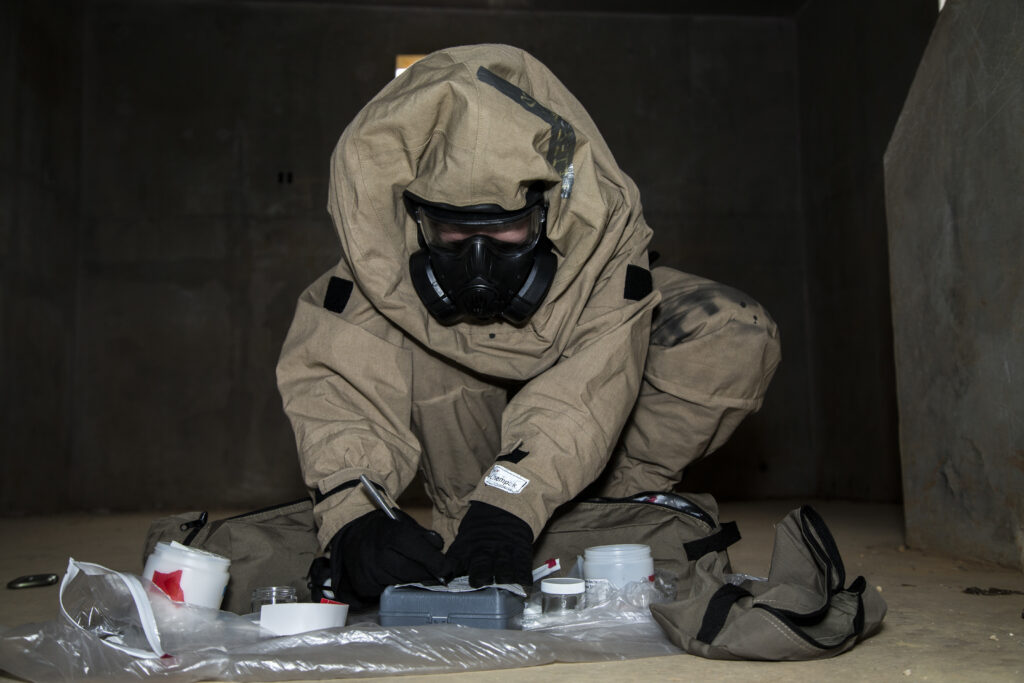
Credit: USMC/Lance Cpl. Jesus McCloud
The oldest technologies are still in widespread use. These consist of wet-chemistry techniques like colour-changing indicator papers and various handheld kits containing ampoules, tubes, or sachets of reactive chemicals. Such papers and kits rely on specific chemical reactions to classify or identify chemical warfare agents. Dräger (DE), KeTech Defence (UK) and Oritest (Czechia) are examples of companies in Europe producing products in this particular segment.
The time-honoured technology for point detection of chemical warfare agents is ion mobility spectrometry. Such devices ionise a sample of vapour, using corona discharge or radioactive isotopes. They then measure how long the sample takes to move down one or more drift tubes. This works out very well for chemical warfare agents as it is very fast and can be done in a small device. Smiths (UK), Bruker (USA-Germany), and Environics (Finland) are the strong players in this technology. The LCD, which was adopted as the M4 Joint Chemical Agent Detector by the US military and has become, perhaps, the most widespread chemical warfare agent detector in the world. An alternative technology is flame ionisation. This is the province of only one manufacturer, Proengin (France), and it merits mention as many countries use it (in the form of the AP4C detector) as a secondary or confirmatory detection method for chemical warfare agents. Various single-gas detection technologies and photoionisation detectors are widespread in civilian safety and emergency response technologies but have less role in military detection. Surface acoustic wave devices had a brief look-in in the 1990s but disappeared.
Chemical identification instruments are more expensive and specialised. This segment of the market has strong overlap with both scientific and emergency responder instrumentation. Fourier Transform Infrared (FTIR) devices shine infrared light through samples to gather absorption spectra. Raman devices shine a laser on a sample and gather the spectral data from Raman scattering. Both techniques can derive the equivalent of a molecular fingerprint which can be compared to libraries to identify a compound. Both can be perplexed by mixtures and combinations. Smiths Detection, Thermo Fisher (USA), Serstech (Sweden), and Rigaku (Japan) are some examples of companies in this space.
Even more definitive field identification can be accomplished by instruments combining gas chromatography (GC) and mass spectrometry (MS) to definitively identify samples. Once strictly the province of analytical laboratories, GC and MS have been downsized over recent decades. First, mass spectrometry went into mobile CBRN recce vehicles like the Fuchs.
Now, man-portable systems such as the Inficon (Switzerland) HAPSITE or the Smiths Detection Guardion bring this capability to specialist CBRN units in the field. GC combined with MS is considered a gold standard in the analysis of chemicals. These will remain somewhat expensive and specialised instruments for the foreseeable future.
The table below provides a summary of available Chemical Detection Technologies:
Biological detection is a mixed bag of technologies with much room for development. Both the 1991 Gulf War and the anthrax terrorism in 2001 resulted in significant investment in the field, but relatively few products have successfully entered the market. Biological detection remains haunted by problems with speed, accuracy, and specificity. The state of the art right now is still not much better than the 1990s. At best, this is after-the-fact ‘detect to treat’ types of detection, not real time ‘detect to warn.’ The latter has remained aspirational for this correspondent’s entire three-decade career.
Trying to do biological detection in the field tends to be broken down into four components, which may be done separately or together in varying scenarios and environments. Air samplers collect particles and droplets for possible analysis. Some systems then look for a sudden spike in the number of particles or droplets in the respirable range, roughly 1 to 10 microns in diameter, as a biological attack would need to be in this size range to be broadly effective. Yet different systems try to use technologies like UV fluorescence or flow cytometry to distinguish between biological and non-biological material. Such technologies still can get flummoxed by natural background matter.
Finally, there are specific techniques for identifying particular pathogens or toxins of known biological warfare utility such as anthrax or ricin. The global COVID-19 pandemic has had the inadvertent effect of making the public broadly familiar with the most widespread of such technologies. Many millions of people have used COVID-19 lateral flow tests and this is the exact same technology as developed in the early 1990s for detection of biological warfare threats. These remain the state of the art for confirming the presence of threats like anthrax or bubonic plague in field samples.
Of all of CBRN detection technologies, radiation detection is the oldest and most technologically mature. Ionising radiation interacts with matter and a number of technologies detect and measure these interactions. To greatly simplify and summarise how such instruments work, gas filled tubes, scintillation crystals, and/or semiconductor materials are used for detecting and measure the various forms of radiation and are coupled with significant data processing electronics that turns the output of the detection media into useful measurements like count rate or dose rate. Variations on this theme can be used for dosimetry, which is this measurement of accumulated exposure over time.
Military requirements are not actually that far away from various use cases in the nuclear power industry, border security, or emergency response. This yields significant crossover in products and markets. Thermo Fisher Scientific, Mirion (which bought Canberra), Laurus Systems, FLIR, and others all have useful products in this area.
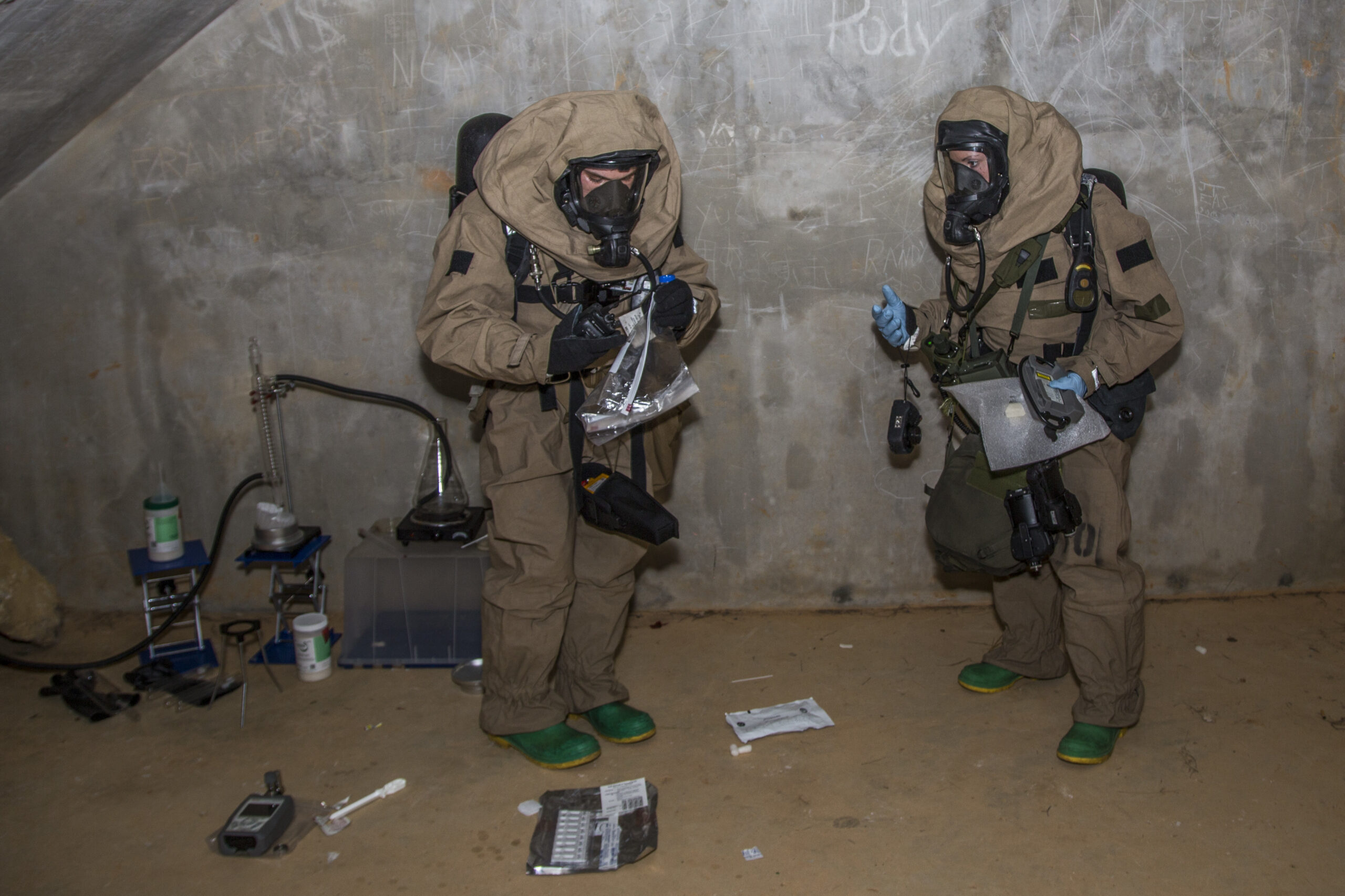
Credit: USMC/Lance Cpl. Jesus McCloud
Diagnostics – An overlooked area
An area usually ignored in military CBRN detection is a fundamentally important one. Many chemical weapons, all biological warfare agents, and radiation sickness have a delay between exposure and onset of symptom. The first indicator of CBRN warfare or terrorism might be a sudden influx of sick soldiers or civilian victims. Therefore, a holistic view of CBRN detection should include post-exposure diagnostics. All too often, military CBRN affairs disregards this aspect or assumes that somehow military medicine has somehow already solved the problem.
Some types of CBRN-induced injury or illness are rather easily diagnosed, such as the specific syndrome caused by nerve agents or, say, the specific visible signs of smallpox or skin lesions from sulphur mustard. Unfortunately, a large percentage of CBRN-related illness or injury may not be obvious to medics. An outbreak of nausea and vomiting, for example, could have either CBRN or non-CBRN-related causes. However, a firm diagnosis of a CBRN injury combined with a narrative of where the victim had been, is useful intelligence that commanders could use.
While research on CBRN-related diagnostics is not unknown, it is less visible and has resulted in far fewer practical capabilities at the field level. Some of the developments in this area remain well inside the domain of hospital and laboratory. For example, the technique of fluoride reactivation to analyse blood samples for exposure to nerve agents after the fact, remains a specialist capability in specific laboratories. Biological dosimetry, the ability to analyse biomedical samples from a patient to estimate their exposure to radiation after that exposure already occurred, is still a speculative science. We are still a long way away from having capabilities at the pre-hospital level, however. Field medics still lack specialist technology in this arena.
Future Prospects: Ubiquity and Connectivity
In terms of detecting hazards, chemical and radiological technologies are fairly mature, and we can expect to see only incremental improvements. As practical revolutionary developments, the exciting future lies in ubiquity and connectivity. Ubiquity should be a goal. Systems are smaller, lighter, and cheaper in relative terms than they were in the past. A military force serious about better force protection can proliferate chemical and radiological sensors around the battlefield. Instead of a specialist squad having to detect threats, there is at present no technical obstacle to every single combat vehicle and infantry squad having a chemical detector and a radiological detector. Every tank and armoured personnel carrier can be a CBRN reconnaissance vehicle today, if only the right people thought about it that way. The obstacles are logistical, budgetary, and bureaucratic, not technical.
Connectivity is just as important as ubiquity. A sensor on a soldier’s belt that gives the soldier good information, but the soldier is distracted because he is fighting a battle (or incapacitated) is of very little value. A soldier reading an output from a sensor and reporting it by voice over a radio network is the cutting edge of 1960 technology. CBRN sensors that disseminated useful information elsewhere on the battlefield would be of great value for situational awareness and contamination avoidance. In effect, all combat units can become CBRN reconnaissance units. Such connectivity exists for other reasons, and it would be a matter of system integration not radical re-invention to make CBRN connectivity a reality.
Biological detection will continue to lag behind. It is possible that some developments will shift this area of technology towards being more useful. This correspondent remembers sitting in a meeting in the Pentagon, being told that a useful field bio detector was about ten years away. That meeting was in 1995.
Dan Kaszeta



